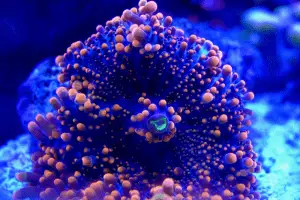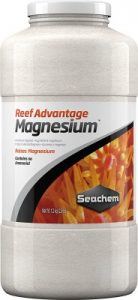Magnesium plays an important role in keeping the reef tank stable. It serves a variety of purposes. Corals and other invertebrates of the reef tank need magnesium to metabolize the calcium. Interacting with the tank water, magnesium also helps dissolve the calcium into the water column. If you experience low magnesium, you need to know how to raise magnesium in a reef tank.
There are two ways to raise magnesium levels in reef tanks. You can either change the water or add magnesium supplements to boost it up.
In this article, I am going to explain how you can safely raise the magnesium level in your reef tank. Let’s go ahead.
Ideal Magnesium Level for Reef Tank
Let me first talk about the required magnesium level so that you can determine the level of magnesium deficiency in your tank and how much magnesium you need to add.
Magnesium in the tank water can be tested with a test kit. You can buy a test kit in any pet shops or online from a reputable brand. Test kits will measure the level of magnesium in ppm.
When it comes to natural magnesium level in the seawater, it is approximately 1285 ppm. According to that standard, the appropriate magnesium level in a reef tank should be between 1250 ppm and 1350 ppm.
If the magnesium level in your reef tank remains between 1200 ppm and 1400 ppm, that does not usually cause any major issues. It is completely okay for the tank creatures to live within that range of magnesium.
However, if the magnesium level drops below 1000 ppm and it becomes consistent, you have to raise the magnesium level to keep the reef tank stable.
Why is Maintaining Magnesium Level So Important?
Magnesium helps the stony corals and other invertebrates in the skeleton formation process. On top of that, it can prevent excessive precipitation of bicarbonate and calcium. If the magnesium level goes below 800 ppm, drop in the pH level is a very possible outcome.
Maintaining the available calcium level for the tank creatures becomes near to impossible without maintaining the ideal magnesium level.
The calcium and magnesium have inseparable connection. When you go for magnesium dosing, ensure that the magnesium and calcium proportion in the water follows a 3 to 1 ratio. Low magnesium will negatively affect the calcium absorbing capacity of the marine creatures.
So, if you have 420 ppm of calcium in your reef tank, you need to maintain a magnesium level of 1280 ppm so that the entire 420 ppm of calcium becomes available for the marine animals to absorb.
In case the magnesium level drops, the amount of available calcium level to the tank creatures will also decrease significantly, even if you find 420 ppm of calcium in the water with your test kit.
Let me give you an example. If the magnesium level drops to 630 ppm in the tank water, the tank creatures will only get about 210 ppm of calcium available for them to absorb, no matter how much ppm of calcium you find in the water with a test kit.
So, if you want to keep the available calcium level about 400-420 ppm, make sure that the magnesium level in the tank is not below 1200 ppm.
How to Raise Magnesium in Reef Tank
 Now that you know why maintaining the right magnesium level is so important, it is time to know how to raise magnesium in your reef tank if it gets below 1000 ppm. Below are two effective ways to boost the magnesium level in your aquarium:
Now that you know why maintaining the right magnesium level is so important, it is time to know how to raise magnesium in your reef tank if it gets below 1000 ppm. Below are two effective ways to boost the magnesium level in your aquarium:
-
Change the Water
If you are experiencing a huge drop in magnesium level, changing the water is the easiest way to bring the proper magnesium level back.
You can start with changing 20% of the aquarium water per week. 10% will be fine in case your tank does not contain stony corals. However, this amount of water change works best for nano reef tanks.
Note that refined magnesium for commercial use is very expensive. As a result, many brands might produce and sell salt mixes with lower magnesium levels. That’s why choosing a reputable brand to buy salt mixes does matter. Choose the salt mixes that are designed for reef tanks containing the right amount of alkalinity, magnesium, and calcium.
In case you’ve got a big aquarium, water changes on a large scale can be really troublesome and time-consuming. Even worse, you might also experience a flood of water on the floor of your living room!
If you are managing a large reef tank and you are not enthusiastic enough to go for larger or frequent water changes, you should go for dosing magnesium supplements instead.
-
Use Magnesium Supplements
 Dosing the magnesium supplements between the water changes is also a very fruitful way to raise the magnesium level to a great extent.
Dosing the magnesium supplements between the water changes is also a very fruitful way to raise the magnesium level to a great extent.
However, adding more than the required amount of magnesium might cause problems as well. That can even produce worse results for the reef tank than inadequate magnesium issue. So, make sure that you test the water before and after dosing the magnesium supplements.
While you buy the magnesium supplement, make sure that you’ve chosen a good brand like Seachem. Seachem’s Reef Advantage Magnesium supplement is widely popular among the reefers for ensuring a blend of magnesium chloride and magnesium sulfate in the water. It comes in powdered form and contains low ammonia.
You are also at liberty to buy liquid supplements instead of the powdered ones. But, that will result in more shipping costs.
When it comes to dosing, start with applying half of the recommended dose from the supplement once per week.
If you’ve bought Seachem magnesium supplement, you can start with 1 teaspoon of the supplement for every 20 gallons of the water volume.
In case of applying the powdered magnesium supplement, make sure that you’ve dissolved 1 teaspoon of powder into 1 cup of freshwater.
Things to Remember When Raising Magnesium in Reef Tank
- Before going to raise the magnesium levels in the reef tank, make sure that you’ve tested magnesium level in the water with a trusted test kit from a reputable brand.
- Most aquariums can bring a balance in the magnesium level with a half dose.
- When it comes to applying the supplement, follow the instructions of your magnesium supplement manufacturer to get the best result.
- Magnesium supplements can come either separately or mixed with calcium. Seachem, for example, adds magnesium to two of their calcium supplements: Reef Advantage Calcium, and Reef Complete. Other calcium products of the same brand do not contain magnesium in them.
- No matter what products you buy, test the level of magnesium in those products to find out the percentage of magnesium to determine whether that amount is enough or not for your reef tank.
- Do not rush for cheap supplements, go for trusted and reputable brands when it comes to buying magnesium supplements.
- Keep checking the magnesium level of the reef tank water between dosing to determine if your strategies are working. It will also help you decide on the next step.
Final Thoughts
I hope that you now know exactly how to raise magnesium in reef tank safely. Note that the water chemistry in a reef tank is more complicated than any freshwater tank. Maintaining the trace elements like calcium and magnesium holds a great value.
Test the magnesium level every time you test the calcium to make sure that you are not overdosing magnesium supplements as that has adverse effects as well.
